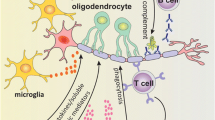Abstract
One of the characteristic features of microglia is their rapid activation in response to injury, inflammation, neurodegeneration, infection, and brain tumors. This review focuses on the role of the microglia in multiple sclerosis (MS), a chronic inflammatory demyelinating disease of the central nervous system (CNS), and in the animal model of MS, experimental allergic encephalomyelitis (EAE). Microglial activation in MS and EAE is thought to contribute directly to CNS damage through several mechanisms, including production of proinflammatory cytokines, matrix metalloproteinases, and free radicals. In addition, activated microglia serve as the major antigen-presenting cell in the CNS, likely contributing to aberrant immune reactivity at this site. A mechanistic understanding of the way in which microglia are activated and ultimately inhibited is crucial for the formulation of therapeutic modalities to treat MS and other CNS autoimmune diseases.
Similar content being viewed by others
Author information
Authors and Affiliations
Additional information
Received: 6 June 1996 / Accepted: 4 October 1996
Rights and permissions
About this article
Cite this article
Benveniste, E. Role of macrophages/microglia in multiple sclerosis and experimental allergic encephalomyelitis. J Mol Med 75, 165–173 (1997). https://doi.org/10.1007/s001090050101
Issue Date:
DOI: https://doi.org/10.1007/s001090050101




